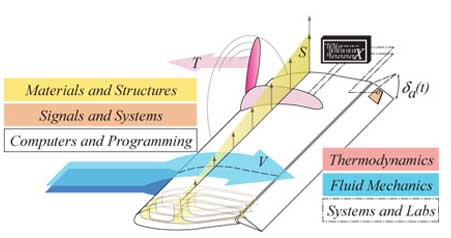“Unified Engineering” Marks Publication Milestone for OCW
- By Jon Paul Potts
- 09/27/04
The MIT OpenCourseWare Initiative now lists more than 900 courses on its Web
site. One of MIT’s most venerable, “Course 16.01: Unified Engineering,”
showcases the active learning and integrated curriculum goals that are the benchmarks of the MIT
Department of Aeronautcs and Astronautics. This signature MIT Aero/Astro course is the largest ever published by
the OpenCourseWare initiative.
Mention this famous course from the MIT
Department of Aeronautics and Astronautics to any MIT Aero/Astro grad from
the last 30 years, and you are certain to get a knowing nod.
It is the bane of every MIT Aero/Astro student’s sophomore year--combining
the disciplines of Materials and Structures, Computers and Programming, Fluid
Mechanics, Thermodynamics, Propulsion, Signals and Systems, and Systems and
Labs, into one year-long course designed to introduce the systemic nature of
aerospace engineering… And now it is the biggest course ever published--by
far--on the MIT OpenCourseWare
(OCW) Web site. The Web site for Course
16.01-04: Unified Engineering I, II, III, & IV marks a major publishing
milestone for MIT OCW, and is enabling the MIT Aero/Astro Department to share
its unique pedagogical approach.
“Unified Engineering is the signature course for Aero/Astro at the undergraduate
level, and it embodies the essence of aerospace engineering education at MIT,”
said Professor Wesley L. Harris, the Aero/Astro department head. “The
opportunity afforded us to publish Unified through OCW brings benefits to the
students, to the faculty involved in the teaching of the materials, and to others
outside of the department and beyond MIT. We are better equipped to continuously
improve Unified Engineering now that it is so easily accessible to our faculty.”
Professor Steven R. Hall is one of the lead instructors on the course, along
with Charles Coleman, Mark Drela, Kristina Lundqvist, Mark Spearing, Ian Waitz,
and Peter Young. “Starting three or four years ago, we really began to
transition to an almost Web-only system. We had been building the site using
DreamWeaver, and if you look at our current site and compare it to what is on
OCW, it is fairly similar. We tended to organize each discipline as a matrix,
with each lecture topic and the corresponding homework, tests, problem sets,
and such,” Hall said.
“We have gone to an active learning program. We use in-class concept
tests and we use ‘muddy cards’ where students can give us feedback.
We began responding to the muddy cards on the Web, and that began to increase
the material we had to transfer to the students. The Web makes that easy to
manage,” continued Hall, who himself took a much lower-tech version of
Unified in 1978-79. “We always had a philosophy where the course would
be open to the world, and OCW lets us do that.”
Unified has been taught as a requirement for MIT Aero/Astro students since
1973, and over the years, close to 2,500 students have struggled with its problem
sets. The “active learning” method of teaching employed for the
course--which was factored into the MIT OCW site design for Unified--is part
of the MIT Aero/Astro Department’s
Conceive-Design-Implement-Operate
(CDIO) initiative. The vision of CDIO is to provide students with an interdisciplinary
education that stresses the fundamentals and is focused on real-world systems
and products. It has been adopted by universities in the United States, Ireland,
Denmark, and Switzerland, among others.
“Among CDIO and OCW’s common strengths are that they are open architecture
endeavors, they offer substantive online resources, and they are generating
great interest in the international education community,” said Professor Edward
Crawley, who has led the development of CDIO. “CDIO offers a framework and benchmarks
applicable to any engineering education program, and with Unified now online,
others can avail themselves of some of the specific tools MIT is using to apply
CDIO in the classroom.”

“CDIO is the framework, the architecture for our undergraduate teaching.
We hang our curriculum on CDIO and certainly OCW enables us to share that framework
with others,” Harris added.
The Unified course site on MIT OCW features more than four times the volume
of educational materials of a typical one-semester MIT course--about 1,500 different
files and learning objects, including video course introductions by Coleman
and Waitz, explaining to MIT OCW users the concepts and pedagogical goals of
Unified; lecture notes; assignments; and documentary video footage of the semester
project. Samples of active learning techniques employed by faculty also are
included.
The publication of Unified came as part of MIT OCW’s publication of 200
new courses on September 17, bringing the total number of courses available
on the MIT OCW Web site
to 906.
Visit the course site for Unified Engineering at http://ocw.mit.edu/OcwWeb/Aeronautics-and-Astronautics/16-01-04Fall2003-Spring2004/CourseHome/index.htm.
About the Author
For more information, you can contact: Jon Paul Potts at [email protected].